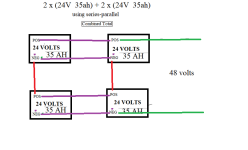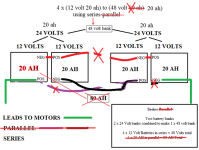my brain is having troulbe tracing the connections, so i redrew it. if yours is teh same as mine, then yes, it will work. if it's not teh same as mine (which is a more conventional way of showing this, and is clearer), then try redrawing yours like mine but with your connections and we'll see if it should work.

basically, if you want double the ah, you have ot have double the number of batteries.
think of it this way. wh is the real measure of capacity, not ah, because wh is v x ah.
if you want a 48v 80ah battery, that is 48 x 80 = 3840wh, which with 12v 20ah (240wh) batteries takes 16 of them to do. if you only use four 48v 20ah batteries to do it, no matter how you hook them up, there's still only 48 x 20, or 960wh in them.
anyway, bigger batteries take more space than smaller ones, so you end up using the same (or more) space for the same wh.
for instance, a 35ah 12v battery takes about twice the space of a 20ah 12v battery.
a 24v battery takes about twice the space of a 12v battery.
so a 24v 35ah battery takes about four times the space of a 12v 20ah battery.
meaning, if you use four 24v 35ah batteries, you still end up taking the space (and weight) of about 16 12v 20ah batteries. there's just less wiring between them.

either way, you'll probably really only get about half the capacity out of them that they're rated for, at the currents you'll be using them at. one of the problems with lead.
something else to think about with the lead is that a 12v 35ah battery probably weighs around 30+lbs, at a guess. so a 24v 35ah would be around 60lbs. four of those is 240lbs.
i've seen specs for as little as 22lbs for such a battery, but...in my limited experience the lighter a lead battery is for a given voltage and ah, the less current it can provide without sagging more in voltage, and the less capacity you actually get out of it for that current draw, and the less number of charge/discharge cycles (and calendar time) it lasts before it begins to fail. those may not all be true at the same time for all lead batteries.
that's the problem(s) with lead...it's huge and it's heavy, for what you get out of it. (short life, high weight and volume, low capacity).

they're still used in a lot of powerchairs and forklifts simply because the lead *is* heavy and is useful as ballast to keep from tipping over. but there are other solutions in use for those, too.







